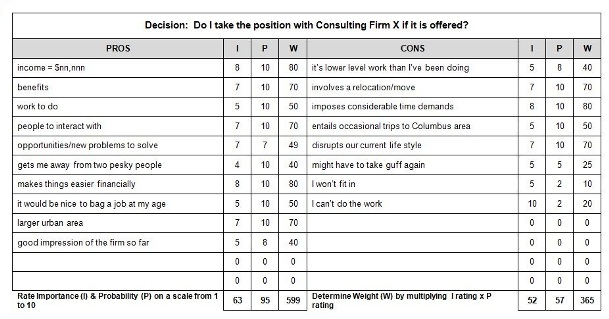Written by Fred Nickols
Benjamin Franklin described his well-known decision-making process in a letter to Joseph Priestley who had asked Franklin's advice about a vexing decision. Essentially, Franklin's process is a matter of listing the Pros and Cons, reflecting on them, and making your decision. This article presents a modified version of Franklin's process. If you'd like to read Franklin's letter to Priestley, click here.
This article describes the steps of the Benjamin Franklin decision-making process and provides a job aid for your use. An example illustrating all the steps is provided.
- Frame the Decision
To decide is to commit to a course of action. Frame your decision as a simple question answerable yes or no regarding some course of action (e.g., "Should I seek new employment?").
- List the Pros and Cons
Brainstorm or jot down an initial set of pros and cons. Don't rush through the process. Take time to reflect on the decision facing you and add to (or subtract from) the Pros and Cons.
- Assess the Importance of the Pros and the Cons
A simple rating scale of 1 to 10 works well here. Extremely important would rate a 10; moderately important would rate a 5 and not especially important would rate a 1.
- Assess the Probability of the Pros and the Cons
In some cases, a Pro or a Con is certain; it rates a 10. In other cases, a Pro or Con might be viewed as likely but not certain; it rates a 5. And, a Pro or Con might be viewed as possible but remote; it rates a 1.
- Weight the Pros and the Cons
Multiply the rating for Importance times the rating for Probability. A Pro that is extremely important (10) and is likely to be realized (5) yields a weight of 50. A Con of extremely high importance (10) but a remote possibility (1) yields a weight of 10.
- Review and Reflect
Review the factors you have listed, their ratings, their weightings and take stock of what they tell you about the decision. Some questions to help you do this are included at the end of the job aid.
A consultant was deciding whether or not to accept a job offer from a large consulting firm. His thinking is shown in the sample job aid and is summarized below:
- The raw number of Pros is greater than the number of Cons.
- There is a noticeable difference in the total of the ratings for importance: 63 for the Pros and 52 for the Cons. There is a pronounced difference between the probabilities: 95 for the Pros and 57 for the Cons. The total of the weighted factors for the Pros (599) significantly outweighs that for the Cons (365).
- The major Pros are tied to pay and benefits.
- The major Cons are associated with moving (i.e., relocating, occasional trips back home and disrupting current life style).
- The most significant Con (i.e., not being able to do the work) has a low probability.
- The basic trade-off, then, is between some highly probable, fairly important Pros against some less important and much less probable Cons.
There were no clear-cut, overriding factors, making the decision more difficult than would otherwise have been the case.
This was far from a "no-brainer" decision but the balance was clearly tilted in favor of taking the position and that is what the consultant decided to do.

Review & Reflection Questions:
- How do the Pros and Cons stack up against one another?
- How does the importance of the Pros compare with the importance of the Cons?
- How does the probability of the Pros compare with the probability of the Cons?
- What is the "mix" of importance and probability? What patterns do you see?
- What do they tell you?
- What is the overall balance of consequences?
- What are you getting?
- What are you giving up?
- Are the trade-offs worth it?
- What are you risking and are you willing to risk it?
- Are there any inconsistencies to be resolved?
- Which factors really matter?
- Are there any overriding factors?
- Who else, if anyone, should you consult? When do you have to decide?
About the Author: My name is Fred Nickols. I am a writer, an independent consultant and a former executive. Visual aids of one kind or another have played a central role in my work for many years. My goals in writing for SmartDraw's Working Smarter blog are to: (1) provide you with some first-rate content you can't get anywhere else, (2) illustrate how important good visuals can be in communicating such content and (3) illustrate also the critical role visuals can play in solving the kinds of problems we encounter in the workplace.